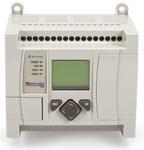MicroLogix PLC
MicroLogix Now Out of Support

- Only the most recently released models MicroLogix 1100 and 1400 offer online programming. For this reason alone, we recommend against buying any of the legacy MicroLogix controllers.
- Each controller suits only one type of expansion IO – refer to table below for compatibility.
- The model family number – 1100, 1500 etc is no indication of relative ranking of features. The latest models are the MicroLogix 1100 and MicroLogix1400, which are far superior to the much older MicroLogix 1500 for example.
- The MicroLogix 1500 requires the purchase of two components – the base and the CPU.
- The serial port on most MicroLogix controllers is a mini-DIN plug. The MicroLogix 1500 1764-LSP CPU provides a second serial port, but this is a 9 pin D-connector allowing use of a standard cross-over cable for programming.
- The standard programming cable is a part-number 1761-CBL-PM02, with a DIN plug one end and 9 pin D-Connector the other.
- For connecting to an HMI, the double DIN plug 1761-CBL-HM02 cable is used.
- The MicroLogix family has no chassis – the ‘backplane’ for data is conducted through each expansion module. Note the (MicroLogix 1500) 1769 family IO also requires this backplane to be terminated with ‘End Covers’
- The 1769 IO family has strict rules concerning the number of modules each power supply can accommodate. The rules are based on the maximum number of modules between the power supply and the module in question.
- Many functions that were built into the PLC and SLC families become optional plugin modules in the MicroLogix family – Real-time clock, backup memory for example.
- Beware of the various power supply and IO voltage versions. There are various permutations of AC and DC, & extra low and low voltage, ordering details for MicroLogix 1100 and MicroLogix 1400 are available on separate pages.
| MicroLogix Family | Model Number | Base IO | IO Capability | IO Expansion Family | Our Ranking | Ethernet Prg/MSG1 | Online Program | Best Choice?2 |
| MicroLogix 1000 | 1761 | 32 | 32 Points | 1761 | 5 | Via Net-ENI | No | No |
| MicroLogix 1100 | 1763 | 18 | 4 Modules / 144 Points | 1762 | 2 | Yes | Yes | Yes |
| MicroLogix 1200 | 1762 | 24 or 40 | 6 Modules / 136 Points | 1762 | 3 | Via Net-ENI | No | No |
| MicroLogix 1400 | 1766 | 32 | 7 Modules / 256 Points | 1762 | 1 | Yes | Yes | Yes |
| MicroLogix 1500 | 1764 | 24 or 28 | 16 Modules / 512 Points | 1769 | 4 | Via Net-ENI | No | No |
- Ethernet network programming, messaging and HMI data connection is available, but distributed IO (such as PointIO for example) is not.
- Recommendation based on project requirements independent of existing or legacy equipment.